

|
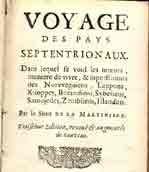
The title-page 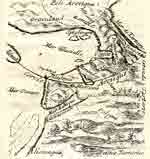
Map 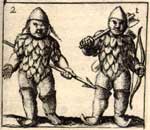
"Native samples" 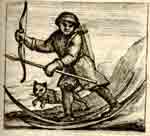
A Sami and his familiar spirit (a cat) 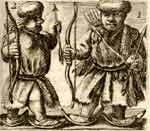
Samoyeds 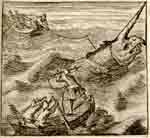
Walrus hunting near Novaya Zemlya 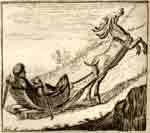
Travel by reindeer sled in Lapland |
The 1670 voyage of la Martinière
It is interesting to note how travelers from leading European nations described their experiences of the Nordic countries, their inhabitants and nature in pre-18th-century accounts. The Nordic peoples, for instance, were regarded as barbarian and uncivilized by continental Europeans during the 1500s-1600s. Demonic darkness was thought to have covered a land that was populated by savages. The landscape, too, was both frightening and dangerous. Due to what he had read in older chronicles, the young Frenchman, Pierre Martin de la Martinière (1634-1690), was mentally prepared for whatever might happen on his northern trek in 1670. He ultimately penned some of the most imaginative writings we have from that era. This was accomplished after having crossed large parts of the northern realms within five months. If he actually experienced everything written about in this renowned book is highly questionable. Pierre Martin de la Martinière published his travel accounts, Voyage des pais septentrionaux (Paris), in 1671. The book received great publicity, and versions of it have been published in Dutch, English and German. The author was 36 years old when he signed on as a ship's surgeon, in a fleet of three trading ships, in Copenhagen, early in May 1670. Belonging to the Northern Trading Company, all three ships had been outfitted by King Fredrik III. Their objective was to sail northwards to discover what kind of trade could be maintained with the indigenous people of the far north. The Danes hoped to barter with tobacco and liquor, and for these commodities they were rewarded well. Before returning to Denmark, the fleet was ordered to report on lands visited and whether trade was feasible with northern inhabitants. The king even demanded to see samples of the local populace and, as a result, four natives from Novaya Zemlya were returned to Copenhagen with the fleet at the end of September 1670. Records show how the "samples" were gazed at in awe and with great interest by the king and his court. Among those kidnapped from Novaya Zemlya were two women and two men; these may have belonged to the Nenets who were known to have inhabited the archipelago at that time. "We knew perfectly well that nearly all the inhabitants living north of the Arctic Circle were sorcerers", la Martinière ascertains at an early point in his narration. He continues by telling his readers about the Varanger Sami. Each Sami family there was known to have a large black cat which they seemed to venerate. "And even though this animal has the face of an ordinary cat", la Martinière writes, "I really believe, to judge from its horrifying glance, that it must be a hell-cat." The Varanger Sami are described as necromancers, while the Russian Samoyeds of northern Siberia practiced cannibalism, and the inhabitants of Novaya Zemlya were known for widespread idolatry. "Occasionally the devil will use their idols", he noted, "to proclaim his infernal utterances." With liquor and tobacco, travelers paid for conveyance by reindeer "across all of Lapland, and the Swedish, Danish and Moscovit regions." And the reindeer, it was said, ran so quickly "…that we believed we had been abducted by evil spirits." During his stay at Novaya Zemlya, la Martinière wrote extensively on walrus hunting, scurvy, idolatry and the difficulties of capturing some of the archipelago's inhabitants. The Frenchman made drawings of a man and a woman who were returned to "civilization" to be exhibited as exotic creatures from the wilds of the far north. In 1670, the expedition continued to Greenland and Iceland in mid-August. Ugly, filthy, wicked and brutal were the adjectives used to describe the Icelanders, most of whom were sorcerers and witches. A description of the active volcano, Hekla, is also written about in several pages of the book's conclusion. Here, in this passage, the ship's surgeon lets his imagination run wild: "Those fishing close to Hekla can observe the many demons flying in and out of the volcano. And souls from all across Europe are collected by the demons", according to his narration. The chronicle was enlivened by the terrifying screams heard originating from Hekla. The devil, la Martinière explains, grills peoples' souls in Hekla's pit fires and then cools them off in the icy coastal waters. This travel chronicle became immensely popular. These adventures were not simply recorded; they also resulted in a figurative depiction of idols and demons disguised as cats, among creatures of various kinds. Altogether there are 20 illustrations in the book. That the book had a great impact on its readers was surely evident in the many attempts to refute the Frenchman's obstinate depictions. Some of these came from the Nordic countries themselves. The Sami missionary, Knud Leem, for instance, who had published his monumental work, Beskrivelse over Finmarkens lapper (1767), wished explicitly to remedy the many wrongs portrayed in Voyage de pais septentrioaux. Tall stories abound in the book, according to Leem. And when the Professor Johannes Schefferus, from Uppsala (Sweden), published his renown Lapponia, in 1673, he happened to use the Frenchman's travel log as an important source of information. But this the Swedish scientist did frequently and with great prudence. Schefferus wrote that the book had highly unlikely accounts, and that La Martinière stretched the truth to awaken curiosity and wonder in his readers. The Swede shows how the Frenchman systematically confuses reindeer with moose, squirrels with weasels, etc., and that his depiction of the Sami lacks general credibility. |

|
© University Library of Tromsø - 1999.
The Northern Lights Route is part of The Council of Europe Cultural Routes. The Cultural Routes are an invitation to Europeans to wander the paths and explore the places where the unity and diversity of our European identity were forged.
|

|